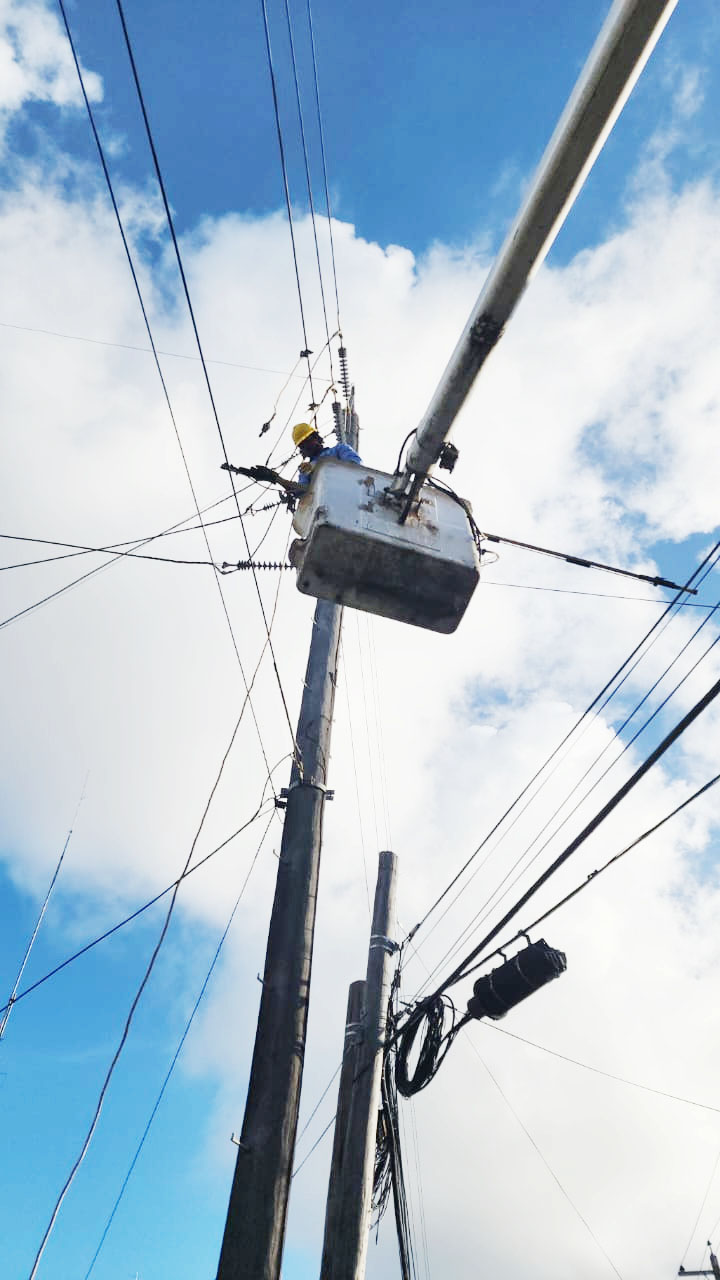Guyana Power and Light Company (GPL) Manage-ment Committee Head Kesh Nandlall said that yesterday morning’s power outage was caused by a “technical issue”.
Many areas in Berbice and Demerara were once again in blackout yesterday when a transmission line tripped at the Kingston facility around 5:49 am.
GPL said in a press statement that its emergency team discovered that a guy-wire had burst and made contact with the L5 Transmission line. At the time, the L5 line was transmitting approximately 15 Megawatts (MWs) of generation, the release noted.
The result was a ripple effect on the grid resulting in several generating units going offline, it added, and disruption in service to customers in Demerara and Berbice.
“Our team immediately commenced restoration efforts and at approximately 6:13 am the first area in Demerara was repowered. Incremental restoration continued until remedial work on the L5 Transmis-sion Line was completed and at 7:34 am all areas were repowered,” the statement read. “Our company remains cognizant of the inconveniences associated with the unplanned service interruptions and continues to work assiduously towards eliminating these occurrences.”
Nandlall told this newspaper that yesterday’s occurrence had nothing to do with the 14 generators that were recently installed to the power grid.
Last week, the government said that 14 of the 17 used generators it purchased for US$27 million from Honduras had been installed. These generators were supposed to have been in place since last year but were delayed by a series of problems including shipping. Shipping delays were also cited as the cause for the generating sets’ current use of diesel fuel instead of Bunker C heavy fuel oil, as they arrived ahead of their heavy fuel oil (HFO) tanks.
Nandlall said last week that the HFO tanks had arrived but were under construction. He added that the generating sets were operating at their dispatch capacity until the tanks were completed when they would be switched to HFO and produce at the 1.7 MW maximum capacity instead of the current 1.2 MW.
“We are focusing heavily on ensuring the current capacity we have is maximised. That involves bringing into production, some of the units that were bought and have not been brought online. They told me that hopefully by Saturday they should be able to get most of the equipment up and running again that will allow us to have the capacity based on peak demand.” Vice President Bharrat Jagdeo had told reporters at a press conference, also held on Thursday. Jagdeo said that the power utility company has the Irfaan Ali administration being bombarded with complaints daily which they are trying their best to resolve.
“GPL continues to give us headaches. We are very much aware of the problems it is causing to many people in this country…,” Jagdeo said. “People’s lives are being disrupted because of this sector. We understand this from a policy-making perspective.”
Meanwhile, President Irfaan Ali last Friday announced that Cuba will assist with engineers to help with GPL. “They have very skilled technical personnel who they are willing to deploy immediately to work in the system and to help us technically,” the President said in an address to the nation.
He informed that following a meeting with Cuban Ambassador, Jorge Francisco Soberon Luis, Havana pledged to have 10 engineers urgently dispatched here.
The President also said that an agreement for emergency generation will be signed with the Qatari power company UCC, which has a strategic alliance in Latin America with Turkish Karpower-ship. This would be a two-year deal for 36 megawatts (MW) from a ship to help offset peak demand.
The power generation vessel, he said, will be here in around 15 days and will be hooked up to the distribution system for the coast, but in the meantime, GPL is working around the clock to ensure the infrastructure is in place to allow for the smooth connection.
According to Karpowership’s website, it started its “energy investments in 1996, and today owns and operates a fleet of 36 powerships with 6,000 MW installed capacity globally and an active construction pipeline. Kar-powership is the owner, operator, and builder of the world’s only Powership [floating power plant] fleet and has an active role in medium to long-term investments, providing access to fast-track, affordable and reliable electricity.”





